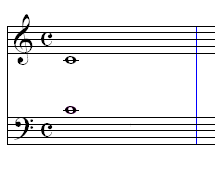
A Stave looks like this:

There are five, parallel lines enclosing four spaces.
High notes are placed at the top of the stave and low notes at the bottom. On a piano, high notes are at the right of the keyboard and low notes to the left. This is the same on a guitar for the left hand, but for the right hand the higher the string, the lower the note. All instruments are different, so our idea of high and low is not always obvious.
Generally, we use two staves and they are distinguished by a clef sign at the beginning of the stave.
The Treble Clef:

and the Bass Clef:

There are two signs in each of the staves above. The first one indicates the clef and you can ignore the second sign, 'C', that comes next for the time being.
The Treble clef tells us that the stave represents notes that are higher than those in the Bass Clef.
The two clefs are often put together as follows and an important note that belongs to neither clef, middle C, comes exactly in the middle of the two clefs and is shown as either a note just below the treble stave or a note just above the bass stave.
Middle C is a very important note for people who play the piano. It has no special significance for other instruments.

There are several things to remember about this note.
1. It is called Middle C. There are lots more notes called C, but this is the middle one.
2. In the treble clef it appears on a new short line just below the stave. This line is called a ledger line.
3. In the bass clef it appears on a ledger line above the stave.
4. Middle C is actually the same note which ever way it is written, and although it is in the middle of the two staves it is not written half way between the two staves. Amazing!
Practise writing the staves, the clef signs, and Middle C.